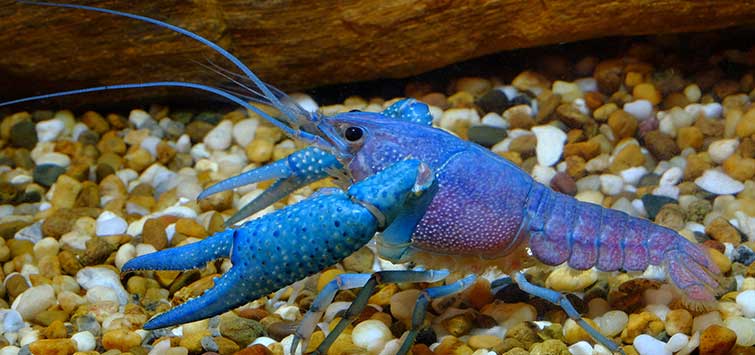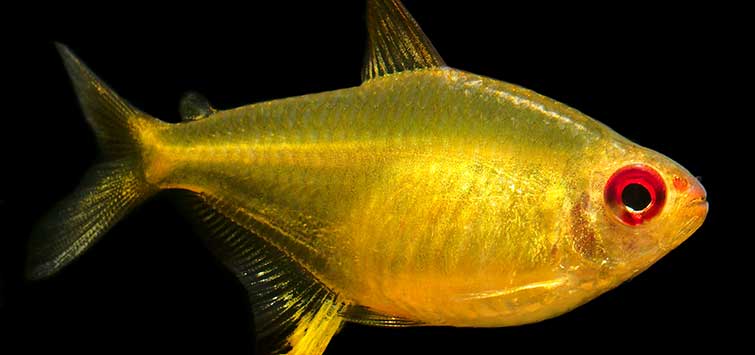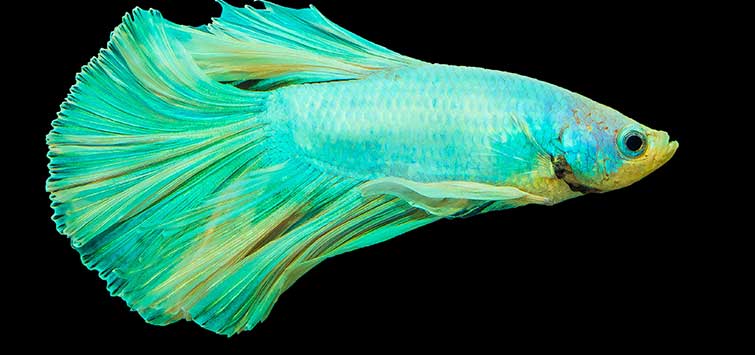Adding Color to the Freshwater Aquarium: Singin' the Blues
Author: Phil Purser
Sometimes the only blue in an aquarium is the water, but one lifelong hobbyist suggests that this color should play a greater role in the tank and offers a list of the best blue fish for your aquarium.
The Beauty of Blue Fish
As I described in a previous article, my first tank had a hunk of blue glass marbled with veins of white. Under the bright lights of my tank, that piece of glass shimmered with sapphire, crystalline fire. Almost as mesmerizing to me as the fish themselves was the way the aquarium’s fluorescent light played off the smooth yet inconsistent surface of that cobaltine ornament. That hunk of glass was the centerpiece of my tank because it was absolutely my favorite color.
The good news here is that there are more blue fish available for the freshwater community tank than ever before. More blue species are farmed and imported every year, and more designer cultivars of blue species are hitting the pet trade. Some of the blues now on the market are spectacular!
Best Blue Fish for Freshwater Aquariums
There are bettas wearing metallic coats of glistening blue, gouramis with scales shimmering in smoky, cerulean hues, and members of the family Poeciliidae with fins coming alive in a virtual electrical storm of radiant blues. You’ll have no reason to be singin’ the blues when you go looking to add a splash of sapphire to your home aquarium.
A good way to categorize the blue fish is by where they spend their time in the water column: the top, middle, or bottom level.
Surface Dwellers
Besides the usual bettas that come in myriad colors, another top-level species is the paradisefish (Macropodus opercularis). Particularly handsome specimens wear a basal coat of silvery blue highlighted with vertical bands of deeper, shinier metallic azure. Variegated bands of lighter and darker blues also adorn the fins. Another species that has been cultivated for coloration, the blue paradisefish’s natural form is greenish gray with bands of orange to rust.
Native to the cool waters of Asia, the blue paradisefish has been a staple of the aquarium hobby since the late 1800s. This top-level swimmer is, like the betta, highly territorial and particularly hostile toward other species with similar coloration or elaborate finnage. Thus, mixing paradisefish and a betta would almost certainly result in a mortal conflict between the two. The paradisefish is a much faster swimmer than the betta and much more prone to jumping; both vegetative cover and a close-fitting lid on the aquarium are absolutely necessary.
Paradisefish require cooler temperatures than most tropicals. Preferring to live at a crisp 61° to 72°F, the paradisefish does not mix well with species requiring warmer waters. While paradisefish can survive in warmer waters, this state is unnatural to the fish’s native habitat and not recommended.
Multiple male blue paradisefish cannot be kept in the same tank without violence ensuing; two males housed together will typically fight to the death. To make matters even more difficult, this species’ semi-aggressive disposition rules out many of the more peaceful community fish as potential tankmates: mollies, guppies, platies, and some of the smaller barbs and tetras. Larger, semi-aggressive species make better tankmates: South American cichlids, channel catfish, members of the Synodontis genus, larger cyprinid species, etc.
A final consideration when adding a blue paradisefish to your aquarium is the level at which the rest of the community thrives. If your tank already has a population of top-level swimmers, this fish may not be the best choice for you. If, however, your tank has lots of bottom dwellers (e.g., catfish, loaches, crustaceans, knifefish, ropefish), a paradisefish might be much more appropriate for your tank. The semi-aggressive blue paradisefish will seldom venture into the depths of the tank.
Blue paradisefish show their best colors under full-spectrum lighting and thrive within a wide range of pH (6.0 to 8.0) and water hardness values. Blue paradisefish in the wild are strict carnivores—insects, fry, and small crustaceans comprise the lion’s share of its menu. Make sure to feed your blue paradisefish a protein-rich diet. Bloodworms, brine shrimp, and high-protein flakes are best.
Midwater Swimmers
Blue Guppies
Let us now descend from the top level of the tank to the middle to explore the next stratum of delightfully blue species you might wish to acquire. Boasting a worldwide following, the fancy guppy owes much of its commercial popularity to the myriad colors in which it occurs. The finnage and body scales of fancy guppies typically have a metallic sheen, which makes the shine and shimmer of their colors all the more appealing and vibrant under bright aquarium lighting. Through decades of extensive selective breeding, there is now a color cultivar of fancy guppy to suit every hobbyist.
While there are a number of bluish guppies available, I’m going to focus on the inexpensive and widely available turquoise fancy guppy. The name of this gorgeous little guppy says it all. Its head is typically silvery, but starting at the dorsal fins, the fish’s coloration transmutes into a rich turquoise that extends, unlike many blue species, right out through the rays of the caudal fin. While a number of fancy guppies may have blue coloration, few can compare with the totality of color offered by the turquoise guppy.
Guppies mix well with a broad spectrum of species. Virtually all non-fin-nippers, non-chasers, and non-predatory species will thrive with guppies. Unlike the species we’ve discussed so far, multiple male guppies can live in the same aquarium without animosity. Guppies thrive in planted tanks that have both superior filtration and minimal water turbulence. Like the betta, the guppy has feathery, elaborate fins that are not very effective when swimming against the strong currents generated by powerheads. Aim any powerheads toward the tank’s walls to decrease the turbulence in the tank.
Live plants not only add security and dietary supplementation (guppies love to nibble on the dead ends of Cabomba and Bacopa) to the guppy tank, they can also add much-needed biofiltration. These blue gems thrive best in the following water conditions: 73° to 80°F, pH 7.0 to 8.0, and kH of 10.0 to 24.0. Fancy guppies also prefer to have some aquarium salt in their tank. This need for relatively hard, alkaline water makes the guppy a good choice for a tank that houses mollies, platies, and swordtails.
Although all varieties of fancy guppy are short-lived fish that seldom exceed 24 to 30 months in age, they can make a wonderful blue addition to the peaceful home aquarium. If you’ve got a little more money to spend (somewhere in the neighborhood of $40.00 per fish), the blue mosaic variety of fancy guppy might be more to your liking. Seldom sold in local or chain pet shops, the blue mosaic fancy guppy is widely available from online breeders.
Blue Dwarf Gourami
Next on the docket is a particular favorite of mine: the cobalt blue dwarf gourami (Trichogaster lalius). Sporting a coat that resembles ethereal scale mail, this fish’s scale coat is a milky, shimmering cobalt blue. Perhaps the most attractive gourami ever cultivated, the cobalt blue dwarf is a mild-mannered species that shows next to no animosity toward any tankmates. Males sport more stunning blues, while females tend toward silvery or slate blues. Though this anabantid fish can gulp air directly from the atmosphere, it does not haunt the top level of the tank like other gourami varieties do.
The advantages to this fish are obvious, and the drawbacks are few and minor. Cobalt blue gouramis do best when housed in small groups of three or more members; lone individuals tend to hide and cower too much, but trios roam the tank readily displaying their shimmering blue coloration. Mixing well in a community of moderately sized, active species (i.e., angels, tetras, platies, rainbowfish, and danios), the cobalt blue dwarf gourami should be maintained under the following water conditions: pH 6.0 to 8.0, medium water hardness, and a temperature of 72° to 83°F.
Growing to no more than 3 inches, these fish are omnivores, and a captive diet that includes both vegetative and meaty fare is recommended. Sadly, the longevity of these cobaltine beauties seldom exceeds four years. As showy as they are gentle, these gouramis come with my personal recommendation for virtually any tropical community aquarium. They really are wonderful and gorgeous aquarium additions.
Cochu’s Blue Tetra
The final mid-level blue fish I’d like to mention is Cochu’s blue tetra (Boehlkea fredcochui). Native to the Amazon Basin, Cochu’s blue tetra (typically sold simply as the blue tetra) is a pleasantly attractive little species that mixes well in the community aquarium. Growing to just under 2 inches, B. fredcochui is a schooling fish that wears a coat of silver with an electric blue streak that increases in both intensity and body coverage toward the caudal fin. Under stressful conditions, this fish may appear gray; poor water quality or malnutrition causes the blue tetra to blanch in color. Under ideal conditions, however, this species’ metallic blue is truly radiant.
Possibly living for over four years in the home aquarium, the blue tetra is a nice balance of hardiness and splendor. Maintain this species at 6.5 to 7.0 pH, 6.0 to 15.0 kH, and a temperature of 75° to 81°F. This species does not do well in tanks containing aquarium salt. And while this blue beauty is generally peaceful, some hobbyists report that it does tend toward frenzied behavior during feeding time; older or more territorial individuals may nip the fins of other tankmates during and immediately following feedings.
In a tank that affords them plenty of cover and territory, however, these fish are wonderful community dwellers. Cochu’s blue tetra is highly resistant to most diseases, highly responsive to most medications, and hardy enough to recover well once an ailment has been purged from the tank. Blue tetras, like the paradisefish or betta, may harass other blue species. Aside from this tendency, they get along with virtually all other non-predatory fish species.
Bottom Goers
Blue Botia Loach
Now let us descend to the lowest level of the tank to discuss the final two blue species. The first is the blue botia loach (Yasuhikotakia modesta). A native of warm, sluggish waters, this fish ranges in color from yellowish (typically females) to blue (males) with grayish undertones. Fins may be yellowish or reddish.
Buyer beware, however, for the blue botia is frequently the victim of dyeing. Whether soaked in a dye bath, fed dye-rich foods, or injected with dye, these fish may not be natural in coloration. A really, reallyaquamarine-colored blue loach is very likely a dyed fish. Likewise, a purple specimen is also unnatural. This coloration will fade in time, assuming the fish lives that long, as the dyeing process is very harmful. Never purchase an animal you suspect has been dyed.
The finest of these fish sport a smoky or cloudy blue color, which, in its muted tones, is quite attractive. Healthy specimens are much bluer than stressed specimens. In the home aquarium, the blue botia needs plenty of hiding places—caves, upturned clay pots, hollow logs, etc. Maintain the pH at 6.5 to 7.5 and kH at 8.0 to 20.0. This species prefers temperatures of 77° to 85°F.
As juveniles, blue botias school together. As they mature, however, these schools will break into a rigid social hierarchy; an alpha will emerge and dominate all others. It should also be noted that the blue botia may grow to 10 inches, so a large aquarium is required. Blue botias live for a long time, too—over ten years is possible.
Mix your botia with larger, semi-aggressive species, for the botia will eat any tankmate small enough to fit into its mouth. Feed your blue botia shrimp pellets, algae discs, brine shrimp, etc. when it is a juvenile, and upgrade to larger meaty fare as it matures: cuts of earthworm, bloodworms, and larger carnivore pellets. Though they are bottom dwellers, large blue botia can be trained to rise to the surface to take live crickets.
Blue Crayfish
The final animal I’d like to suggest adding to your aquarium is the blue crayfish. Yes, I am cheating, slipping an invertebrate into an article dedicated to fish species, but I think you’ll really like this little invert. For starters, there are over a dozen species of blue-colored crayfish worldwide. The species most commonly available in pet shops is the one that concerns us here: Procambarus alleni. Simply sold in pet shops as the blue crayfish or electric-blue crayfish, P. alleni can add one of the truest blues possible to your aquarium. Its carapace is ice or electric blue from top to bottom and may be veined with darker streaks of blue and knobs of white.
Growing to a maximum length of roughly 5 inches, the blue crayfish is a scavenger but will prey on smaller fish in your tank. This invert likes to climb plants or dÉcor under the cover of night and use its formidable claws to snare unsuspecting fish. Even a well-fed electric-blue crayfish may prey upon the occasional tankmate. Avoid this in your aquarium by mixing the blue crayfish only with species that either live above its attack range (such as hatchetfish, bettas, mosquitofish, etc.) or are too large to be eaten. Within my own tanks, I’ve had great success mixing one or more blue crayfish with small oscars, catfish of the genus Synodontis, channel catfish of appropriate size, and a number of other South American cichlids and ropefish.
Electric blue crayfish thrive at a pH of 6.5 to 7.7, kH of 1.0 to 20.0, and temperature of 65° to 80°. Devout omnivores, these crayfish will also actively feed on live plants within the aquarium. Shrimp pellets and flake foods are appropriate for the captive diet. Tightly cover your tank; blue crayfish may climb air hoses and escape your aquarium if these ports are unsealed.
Beautiful Blues
As I said at the outset of this article, there are simply too many blue species to cover here. Do your homework and find the species that is compatible in your tank and has just the right shade of blue you’re looking for. Depending on your tank’s chemistry and established residents, you have a lot of options. Remember that the fish you see in the pet shop’s tank will likely be faded or washed out in coloration owing to stress or poor diet. That same fish may develop deeper, richer blues once established in your aquarium.

.png?h=595&iar=0&w=2781&hash=5FD5E69473BCC22199FBFA2FB71B6033)



